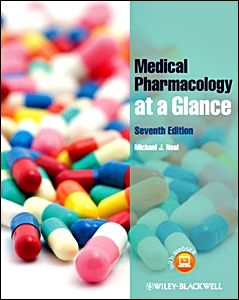Medical Pharmacology at a Glance,7/e
Widely recognised as the best starting point for pharmacology study, the internationally best-selling Medical
Pharmacology at a Glance is an ideal companion for all students of the health sciences.
Key principles are supported by coloured schematic diagrams - invaluable as both an introduction to medical
pharmacology, and revision in the run-up to pharmacology exams.
1 Introduction: principles of drug action, 8
2 Drug뻭eceptor interactions, 10
3 Drug absorption, distribution and excretion, 12
4 Drug metabolism, 14
5 Local anaesthetics, 16
6 Drugs acting at the neuromuscular junction, 18
7 Autonomic nervous system, 20
8 Autonomic drugs acting at cholinergic synapses, 22
9 Drugs acting on the sympathetic system, 24
10 Ocular pharmacology, 26
11 Asthma, hay fever and anaphylaxis, 28
12 Drugs acting on the gastrointestinal tract I: peptic ulcer, 30
13 Drugs acting on the gastrointestinal tract II: motility and secretions, 32
14 Drugs acting on the kidney: diuretics, 34
15 Drugs used in hypertension, 36
16 Drugs used in angina, 38
17 Antiarrhythmic drugs, 40
18 Drugs used in heart failure, 42
19 Drugs used to affect blood coagulation, 44
20 Lipid-lowering drugs, 46
21 Agents used in anaemias, 48
22 Central transmitter substances, 50
23 General anaesthetics, 52
24 Anxiolytics and hypnotics, 54
25 Antiepileptic drugs, 56
26 Drugs used in Parkinson뭩 disease, 58
27 Antipsychotic drugs (neuroleptics), 60
28 Drugs used in affective disorders: antidepressants, 62
29 Opioid analgesics, 64
30 Drugs used in nausea and vertigo (antiemetics), 66
31 Drug misuse and dependence, 68
32 Non-steroidal anti-infl ammatory drugs (NSAIDs), 70
33 Corticosteroids, 72
34 Sex hormones and drugs, 74
35 Thyroid and antithyroid drugs, 76
36 Antidiabetic agents, 78
37 Antibacterial drugs that inhibit nucleic acid synthesis: sulphonamides, trimethoprim, quinolones and
nitroimidazoles, 80
38 Antibacterial drugs that inhibit cell wall synthesis: penicillins, cephalosporins and vancomycin, 82
39 Antibacterial drugs that inhibit protein synthesis: aminoglycosides, tetracyclines, macrolides and chloramphenicol,
84
40 Antifungal drugs, 86
41 Antiviral drugs, 88
42 Drugs acting on parasites I: helminths (worms), 90
43 Drugs acting on parasites II: protozoa, 92
44 Drugs used in cancer, 94
45 Immunosuppressants and antirheumatoid drugs, 96
46 Poisoning, 98
47 Adverse drug reactions, 100
Case studies and questions, 102
Answers, 104
Index, 108


